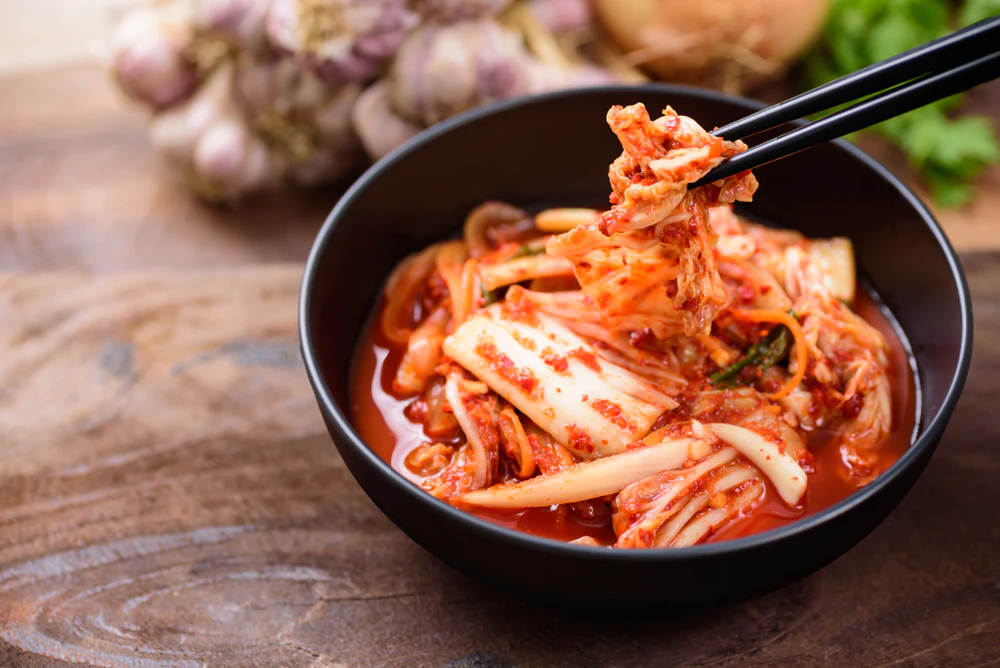Korean Kimchi Recipe
Welcome to the world of Korean Kimchi Recipe, where bold flavors and rich traditions come together in perfect harmony. Among the treasures of Korean cooking, there’s one dish that stands out—kimchi. This spicy, fermented cabbage dish has captured the hearts and taste buds of people around the globe. Learning how to make your own authentic Korean kimchi recipe is not only a culinary adventure but also a way to infuse your dishes with a piece of Korea’s vibrant food culture.
In this comprehensive guide, we’ll walk you through the step-by-step process of crafting traditional Korean kimchi recipe from scratch. From gathering the finest ingredients to mastering the fermentation process, you’ll soon be savoring the delightful tang and heat of homemade kimchi. So, put on your apron and prepare to embark on an exciting journey into the heart of Korean cuisine!
Korean Kimchi Recipe Ingredients
For the Kimchi Paste:
- 2 cups of high-quality Korean red pepper flakes (gochugaru): These provide the signature fiery kick to your kimchi.
- 1/4 cup of fish sauce: Adds a savory umami depth to the kimchi.
- 1/4 cup of salted shrimp (saeujeot): A key ingredient that enhances the unique flavors of kimchi.
- 1/4 cup of sugar: Balances the heat with a touch of sweetness.
- 1 small onion, finely chopped: Contributes to the kimchi’s complexity.
- 5 cloves of garlic, minced: Infuses the kimchi with aromatic garlic goodness.
- 1 thumb-sized piece of ginger, grated: Provides a zesty, aromatic note.
- 2 tablespoons of soy sauce: Adds an extra layer of umami.
- 1 tablespoon of rice flour: Helps thicken the paste.
- 1/4 cup of water: Needed to prepare the rice flour.
For the Vegetables:
- 2 medium napa cabbage heads: The star of the show.
- 1 daikon radish, cut into matchsticks: Adds a delightful crunch.
- 4 green onions, cut into 2-inch pieces: Imparts a mild oniony flavor.
Directions
- Prepare the Cabbage: Begin by cutting the napa cabbage heads in half lengthwise. Sprinkle salt evenly between the leaves, paying special attention to the thicker parts. Allow the cabbage to rest for 2 hours, turning it occasionally.
- Rinse and Drain: After the salting period, rinse the cabbage thoroughly under cold running water to remove any excess salt. Squeeze out the water and place the cabbage in a colander to drain for approximately 30 minutes.
- Make the Kimchi Paste: In a saucepan, combine the rice flour and water. Cook over low heat until the mixture thickens, then allow it to cool. In a spacious bowl, blend the cooled rice paste with the Korean red pepper flakes, fish sauce, salted shrimp, sugar, finely chopped onion, minced garlic, grated ginger, and soy sauce. This is the heart and soul of your kimchi.
- Combine Vegetables and Paste: Now, incorporate the daikon radish and green onions into the kimchi paste, ensuring that every morsel is generously coated with the flavorful mixture.
- Stuff the Cabbage: With the paste ready, gently spread it between the cabbage leaves, ensuring each leaf receives its fair share of the deliciousness.
- Ferment: Place your beautifully stuffed cabbage into an airtight container, pressing it down to remove any trapped air bubbles. Seal the container and allow the kimchi to ferment at room temperature for 1 to 2 days, depending on your desired level of fermentation. Once fermented to your liking, transfer it to the refrigerator, where it can be stored for up to a month.
How to Prepare
To serve, scoop out a portion of your homemade korean kimchi recipe, chop it into bite-sized pieces, and let your taste buds revel in its bold flavors. You can enjoy it as a delectable side dish or incorporate it into various Korean recipes like kimchi fried rice or kimchi stew.
Preparation Time
- Preparation: 2.5 hours
- Fermentation: 1-2 days
Nutrition Facts
- Calories: 45
- Fat: 0.5g
- Sodium: 720mg
- Carbohydrates: 9g
- Fiber: 2g
- Sugars: 4g
- Protein: 2g
Storage Conditions
To maintain the freshness of your homemade korean kimchi recipe, store it in an airtight container in the refrigerator. Properly stored, it can retain its quality for up to a month, and the flavors will continue to develop over time.

Korean Kimchi Recipe FAQs
Q1: Can I substitute regular chili flakes for Korean red pepper flakes? A1: While Korean red pepper flakes (gochugaru) provide a unique flavor, you can use regular chili flakes if you don’t have gochugaru on hand.
Q2: What can I use instead of fish sauce for a vegetarian version of kimchi? A2: To make a vegetarian kimchi, you can substitute fish sauce with soy sauce or opt for a vegan fish sauce alternative.
Q3: Can I adjust the spiciness of the kimchi to suit my taste? A3: Absolutely! You can control the level of spiciness by adjusting the amount of Korean red pepper flakes you use.
Q4: How can I tell if my kimchi is fermented enough? A4: To check the fermentation progress, taste a small amount. If it has the desired tanginess and flavor, it’s ready to be refrigerated. If not, continue fermenting at room temperature.
Q5: Is it possible to freeze kimchi? A5: Freezing kimchi is not recommended, as it can alter the texture and flavor. It’s best enjoyed fresh or refrigerated.
Conclusion
Creating your own authentic Korean kimchi recipe is not just a culinary endeavor; it’s a connection to the rich heritage and flavors of Korean cuisine. Armed with this detailed guide, you’ll master the art of making kimchi and infuse your meals with the bold, spicy essence of Korea. Whether as a side dish or an integral ingredient in various Korean dishes, your homemade kimchi is sure to impress. So, dive into the world of fermentation, savor the vibrant flavors, and share the joy of homemade korean kimchi recipe with family and friends. Happy fermenting!


Leave a Reply